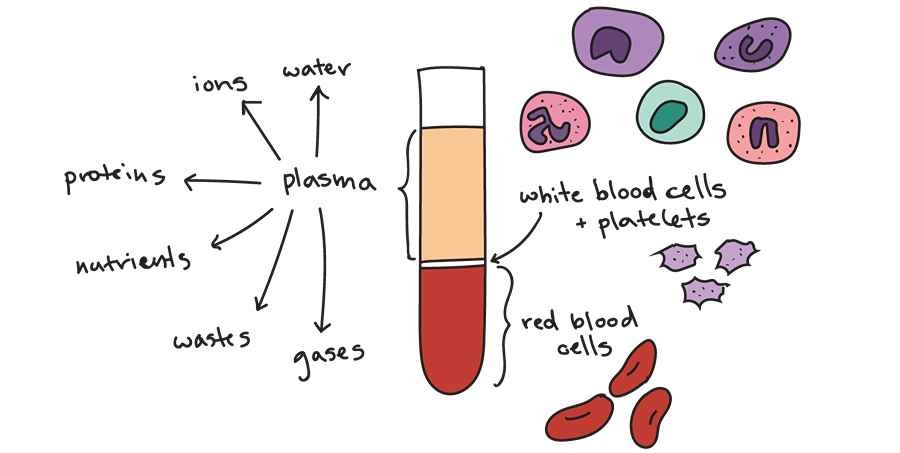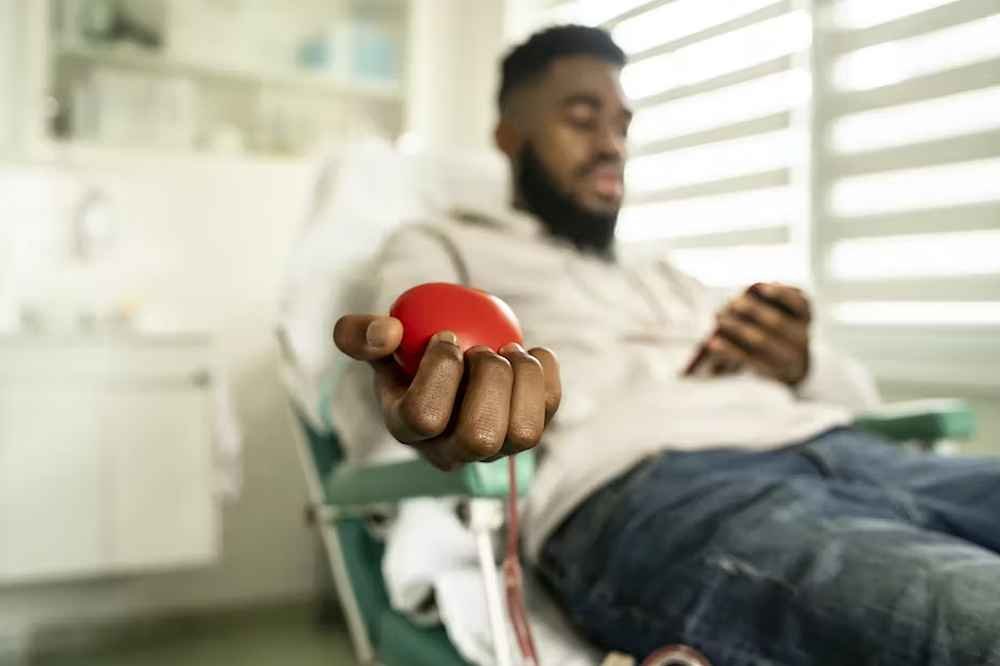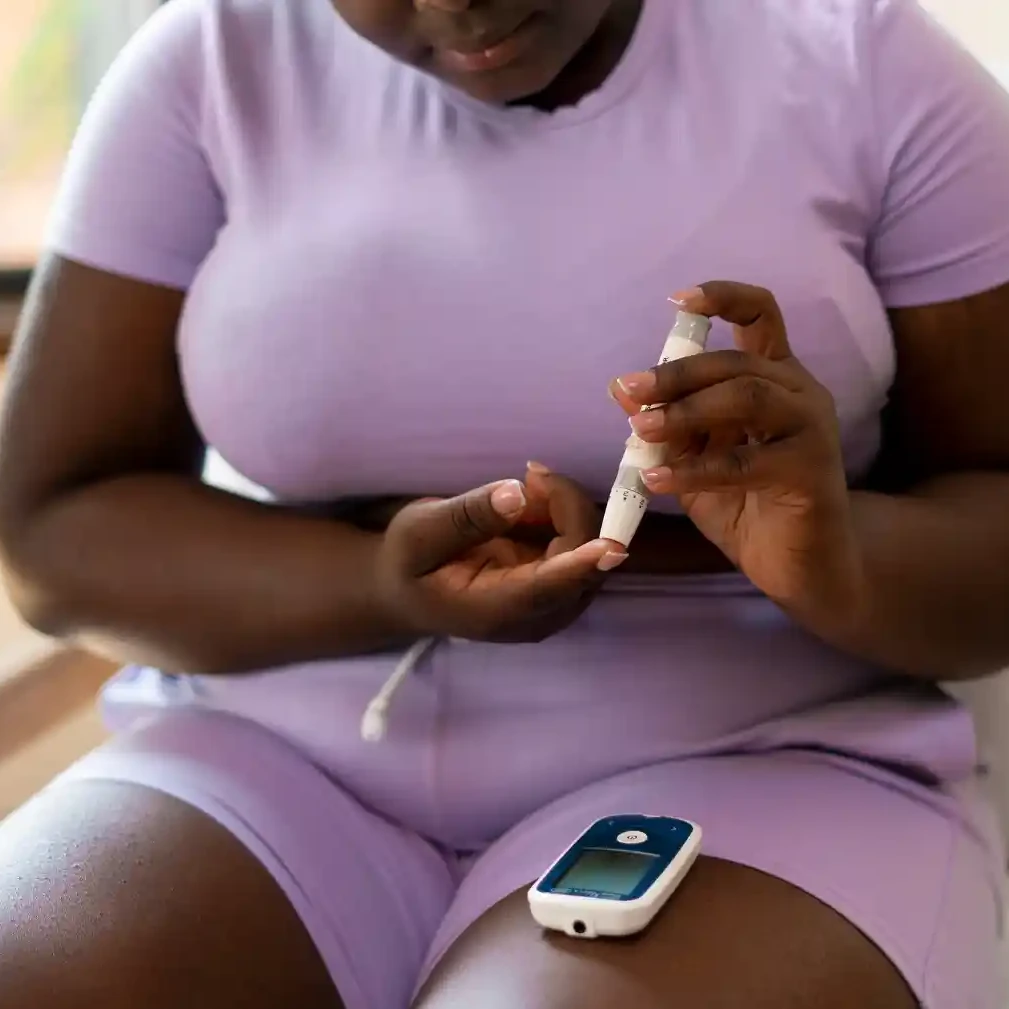Jump to...
- The human blood and components
- Blood donation
- Types of blood donation
- Benefits of blood donation
- Eligibility criteria for blood donation
- What you should do before donating blood
- What you should not do before donating blood
- People who should not donate blood
- Blood screening tests
- Routine blood screening tests
- The importance of laboratory blood screening
- The outcome of blood screening
Every day, many lives are saved through timely medical interventions such as blood transfusions.
Blood transfusion involves receiving parts or whole blood from donors.
Blood banks store donated blood in special bags.
However, blood banks must ensure that the donated blood is safe for administration through adequate blood screening.
The human blood and components

The blood is that sticky red fluid that seeps out when you mistakenly cut yourself.
Almost half (45%) of that fluid contains several types of cells: red blood cells, white blood cells, and platelets.
- Red blood cells (RBCs) are the oxygen carriers. They contain the pigment hemoglobin, which gives your blood its red color and binds to molecules of oxygen. This coloring property of red blood cells earned them their name.
- The white blood cells are the infection fighters, constantly guarding your body against germs and microorganisms. They are called white blood cells because they do not have color.
- The platelets contain the clotting factor. The platelets help your blood stop flowing from wounds or other sites of skin damage.
The second portion of your blood (about 55%), the liquid part, is the plasma.
The plasma contains several proteins and other nutrients vital to the function of your blood.
The plasma moves the suspended cells around your body and takes the wastes to your kidneys and liver for removal.
On average, each person has about 5 liters of blood in constant circulation in the body.
The blood vessels transport your blood throughout your body.
The arteries carry oxygenated blood to your organs, while your veins take used (deoxygenated) blood back to your heart for cleaning and recirculation.
The heart pumps about 2000 gallons of blood every day.
Your doctor can know the types and numbers of cells, especially the RBCs and WBCs in your blood, through the Complete Blood Count (CBC)/Full Blood Count (FBC).
Blood donation

The act of donating blood itself is voluntary and usually attracts no remuneration.
Nevertheless, some commercial donors accept payment for every pint of blood given.
According to the World Health Organization, blood donated by unpaid volunteers from low-risk populations is the safest.
The focus of blood donation is to have a constant supply of safe blood for people who need a blood transfusion.
Types of blood donation
1. Whole blood
Here, you donate pints of whole blood, which can later be separated according to requirements.
2. Apheresis
A machine separates the needed blood component from your whole blood and returns the rest to your body.
Plasmapheresis and plateletpheresis are terms for the donation of plasma and platelets, respectively.
Double red cell donation means you can donate twice the amount of red blood cells you normally would.
Aside from ensuring that the blood bank does not run out of blood to save the lives of those who need it, you can also benefit from periodically donating your blood.
Benefits of blood donation
- It reduces the risk of excess iron intake by your body.
- It reduces the risk of developing cancer by maintaining healthy levels of iron in your body.
- Your heart and liver will thank you for it. Blood donation decreases your chances of developing heart and liver diseases.
- It helps you stay mentally well.
- It provides an opportunity to do your routine checkups and quickly point out what is going on.
- It helps in weight loss.
Your blood production increases as the body works hard to replace the lost blood.
Eligibility criteria for donating blood
For you to be allowed to donate blood, you must fulfill the following criteria:
- You must be healthy. A quick check-up will confirm this at the donation point or center.
- You must be an adult and in a position to give consent.
- You must weigh at least 110 pounds. Underweight adults are not allowed to donate blood.
- You must be certified okay by a medical officer at the donation center.
What you should do before donating blood
While donating blood poses no risk to you as long as you are certified healthy and able to give, some actions will help you be a better donor.
- You should get adequate rest.
- You should eat well.
- Take enough fluids, especially water, before the procedure.
What you should not do before donating blood
You should avoid doing the following as much as possible to have a smooth blood donation process.
- Do not eat fatty foods before donating blood because they can interfere with some necessary test results.
- Avoid using some medications, such as antimalarial drugs, before the donation. If you are up for platelet donation, stay away from aspirin.
People who should not donate blood
According to the World Health Organization, anyone in the high-risk group cannot donate blood to avoid the possibility of transferring blood-borne infections.
Anyone in the following group is a high-risk person and cannot be allowed to donate blood.
- Someone who has ever injected illegal or non-prescribed drugs
- Any man who had sexual relations with another man anytime up to 12 months before the donation
- Anyone with a congenital coagulation factor deficiency
- Someone who tests positive for HIV
- Someone (regardless of gender) who exchanges sex for drugs or money
- Someone with hepatitis B/C has come into contact with someone with it 12 months before the blood donation
- Anyone with serious conditions or diseases such as cancer, severe heart and lung diseases, Chagas, babesiosis, etc
- Anyone with unexplained weight loss of about 5kg in 6 months.
Blood screening tests

Every drop of blood you donate is precious and needed by someone.
However, before your blood can get to someone who needs it, it must be thoroughly screened by experts to rule out the presence of any blood infection.
Screening of donated blood also ensures that the right blood type gets to each recipient.
Blood screening is purely for safety purposes and not to notify you of test outcomes.
Donated blood must pass through a 5-layer blood screening security system before it can get to recipients.
1. Donor screening
This is the first step in getting safe blood through a donation.
You must go through a comprehensive checkup by answering direct questions to gather your medical history before you can donate.
Once you are marked ineligible, you get excused from the exercise.
2. Donor referral list
Deferred donors are those considered ineligible for blood donation.
Each center keeps a list of deferred donors and should check each donor against it before collecting or using the collected blood.
3. Blood testing
The blood establishment runs several tests on your blood to ensure it is safe for use.
It is compulsory to check donated blood for infections and their agents, such as HIV, Hepatitis B and C, syphilis, West Nile virus, Chagas, human T-cell lymphotropic viruses (HTLV), and Zika virus.
Medical personnel must also check for blood group and Rhesus compatibility before giving blood.
4. Quarantine
The blood collected must be certified safe before use.
The quarantine is the period between collection and result release.
5. Problems and deficiencies
If the test results are unsatisfactory, the blood center should investigate the reason for such outcomes.
Routine blood screening tests
1. Blood typing
Routine blood typing determines your blood group and Rhesus factor.
There are four blood groups (A, B, AB, and O) and two Rhesus types (Rh+ve and Rh-ve).
Wrong blood matching during a blood transfusion can lead to fatal reactions and complications.
For example, you can only receive blood from another blood group O if your blood group is O.
The reason is the presence of anti-A and anti-B antibodies in your blood.
Anything other than that causes problems.
The same principle applies to the Rhesus type.
An Rh-ve gets blood from another Rh-ve blood, and a Rh+ve collects blood from another Rh+ve blood.
Subsequent blood transfusions will lead to fatal complications if wrong matching occurs during a blood transfusion.
2. Direct agglutination test or direct Coomb’s test
Your red blood cells are covered with antibodies.
Your doctor must analyze the antibodies to avoid the wrong matching of blood.
The examples in the blood typing section are the results of antibodies on the RBCs.
The direct agglutination test mimics what happens in the body when blood samples are matched.
The importance of laboratory blood screening
- The first and most obvious reason is to avoid blood compatibility issues during a blood transfusion
- The test also comes in handy if you are pregnant. Detecting the Rh type of the fetus of an Rh-ve mother aids early intervention and avoids subsequent miscarriage.
- To detect the presence of possible underlying autoimmune diseases where your body makes antibodies that target and kill your RBCs.
- To detect drug-induced anemia. In this case, some drugs, such as penicillin, trigger your body to produce antibodies against your RBCs.
The outcome of blood screening
The purpose of blood screening is to know whether your blood is safe for administration or not.
You won’t be notified of the results once they are out.
However, the blood center may decide to further investigate the unsatisfactory outcome.
Conclusion
Do you know that your RBCs only live for 120 days?
That means that after every 120 days, your body gets rid of old RBCs and produces new ones.
Instead of that, why not donate them today to save someone’s life?
An accident victim, a pregnant woman, or a surgery patient somewhere relies on you to live.
Blood donation is safe and not time-consuming.
Find the nearest blood donation center or blood bank around you today and save a life.
Christianah Akinola
Christiana is a creative, swift, and directional writer. She is a graduate of the Obafemi Awolowo University, Ile-Ife, and has her M.Sc (Medical Microbiology) from the College of Medicine, University of Lagos, Idi-Araba. She is the proud author of “Fearless- Boys don’t cry.” She enjoys playing games and singing.



